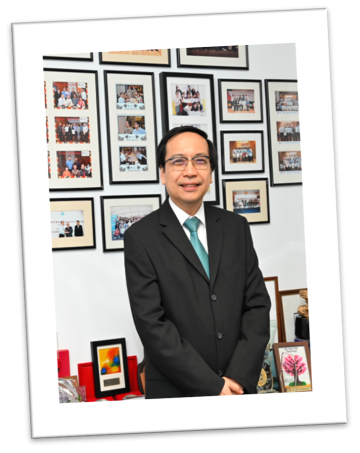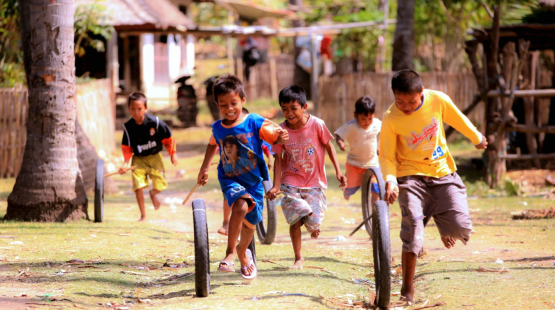IACAPAP President's Message Sep 2022
Good moon rising: IACAPAP in the Metaverse

This is the period of the mid-autumn festival which is celebrated in many parts of East Asia. It is a time of celebrating the harvest and believed to be the largest and roundest full moon for the year. I have many childhood memories of carrying a lantern and playing with candles during this period. The delicious mooncakes traditionally made of lotus seed paste is wrapped around orange balls of salted egg yolk. If you are fortunate, the mooncake can carry up to 2 yolks although it is equally nice to just savour the sweet lotus seed paste. These days, the mooncakes are much more elaborate with all kinds of fillings including chocolate and various flavours common in our region including the rather acquired taste of durian, known as the king of fruits. The mooncakes in Singapore are exquisitely packed into all forms of attractive boxes which are collectibles in their own right. The carrying of lanterns and the eating of mooncakes remind me of the importance of culture and tradition in understanding the mental health of children.
Children do not develop in a vacuum, but are wrapped sometimes tightly, and in other times, more loosely in the environment created by their caregiving adults. These developmental phases form important sensitive periods for children. Sensitive because they can affect children positively, allowing them to grow with confidence and happiness so as to become well adjusted, stable adults. Conversely, these could be adverse experiences that may warp and, in severe circumstances, traumatise a child. Traditionally, the adverse experiences focus on family disruption including acrimonious separations of parents, problematic parental conflicts and mental illness poorly managed in parents. Today, there are new challenges to the environment of the child. A baby born in this age of infocomm technology (ICT) can be exposed to potentially adverse experiences within very loving and caring families. Infocomm refers to information and communication. Media is the channel upon which information and communication reach our children. Information is knowledge but we know that some knowledge requires developmental maturity to process effectively. What happens when a young child is exposed to violence on new media? Communication is about the ways that children learn language and express their views through it. Again, new media, which is now highly interactive may change that dynamic. As a child develops into adolescence, new media becomes increasingly interactive and forms new ways in which information and communication is part of a social process. Hence the term social media. Today, we speak less of the impact of social media but more of how our children and adolescents must live with social media, much like how we deal with a pathogen that has become endemic. The old adage, if you can’t beat them, join them is fairly true, as there is no way to exclude a growing child from media. There is a need for mental health professionals working with children and adolescents to embrace social media, dissect its difficulties but use its pervasiveness for the greater good. The culture of knowing the news instantly, learning global practices and traditions extensively as well as reacting to emotions openly, is a global one. I reckon that all the practices and traditions which used to define our geographic and social standing is now coming together in the connected global village. So, we as mental health professionals must learn to harness this new globalised culture and build on its strengths to help children and adolescents grow to their potential. How can we do this?
1) Do not hide behind professional boundaries when communicating with youths. Be accessible to them in various ways. Allow youths to connect with you beyond the physical consult. It is possible to monitor an email conversation as part of professional supervision, sometimes better than just sharing in a regular meeting with peers and supervisors. Emails and other communications channels allow better monitoring of boundaries than supervision discussions because the communication is captured verbatim.
2) Learn to understand the various forms of evolving social media that our young patients gather in and see the good along with the bad. A good coach needs to understand the game as much as knowing the players. I often meet psychiatrists who tell me they have no social media and don’t see its value. This will make working with youths much more difficult. So I recommend that all child and adolescent mental health professionals get onto social media.
3) Create content that promote mental health literacy. Tik Tok is now one of the fastest growing social media platforms. I have no stake in Tik Tok but I recognise the value of trying to produce content which can reach young people. The same can be said of Facebook, Instagram and many other social media channels that the young may congregate. Fight fake news with real content that informs, advise and support young people in distress.
4) Work with ICT to develop mental health interventions and not keep our traditional modes of assessment and therapy. Telehealth has developed by leaps and bounds but our therapists have not. See the possibilities in our latest online IACAPAP textbook chapter here (https://iacapap.org/_Resources/Persistent/1570258ef47b59331d7a4521f65a3d60daac8797/A15-Telepsychiatry%20A_R1.pdf)

My term as President of IACAPAP, like the full moon, has come full circle and it has been 4 years since I took on the responsibility of shepherding this august and tradition bound organisation to what we, in the executive committee, believe to be the way forward. I feel that technology is not just an enabler in our work. It is part of the new culture of the global village that is needed to raise a child. We have accepted that information and technology is the backbone for IACAPAP. The online e-textbook will be evolving into a new form led by a new editorial team. Hesham Hamoda is our new Director for Communications who will set the pace for harnessing social media and our next World Congress, aptly themed, “Shaping the Future” will be in Dubai, a technologically advanced city. Imagine the possibilities, realise the challenges and see you all in December in Dubai as we march forth into the brave new world!

